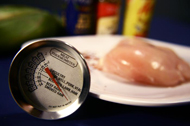
Did you know that 1 in 6 Americans get sick from foodborne illnesses each year?
This problem is more serious than many people realize. Foodborne illnesses send more than 120,000 Americans to the hospital each year and result in approximately 3,000 deaths.
View Food Safety Alerts
Food Safety at Home
Following these
four simple steps can help keep you and your family safe from food poisoning at home.




CLEAN: Wash hands and surfaces often

Illness-causing bacteria and viruses can survive in many places around your kitchen, including your hands, utensils and cutting boards. Unless you wash your hands, utensils and surfaces the
right way, you could spread these germs to your food and your family.
- Wash hands
the right way — for 20 seconds with soap and running water. Be sure to scrub the backs of your hands, between your fingers, and under your nails.
-
Wash surfaces and utensils after each use. Rinsing utensils, countertops and cutting boards with water won’t do enough to stop bacteria from spreading. Clean utensils and small cutting boards with hot, soapy water. Clean surfaces and cutting boards with a bleach solution.
-
Wash fruits and veggies — but not meat, poultry, or eggs. Even if you plan to peel fruits and veggies, it’s important to wash them first because bacteria and viruses can spread from the outside to the inside as you cut or peel them.
SEPARATE: Don't cross-contaminate
Even after you’ve cleaned your hands and surfaces thoroughly, raw meat, poultry, seafood and eggs can still spread illness-causing germs to ready-to-eat foods—unless you keep them separate.
COOK: Cook to the right temperature
One of the basics of food safety is cooking food to its proper temperature. Foods are properly cooked when they are heated for a long enough time and at a high enough temperature to kill the harmful bacteria and viruses that cause foodborne illness.
While many people think they can tell when food is “done” simply by checking its color and texture, there’s no way to be sure it’s safe without following a few important but simple steps.
CHILL: Refrigerate promptly
Illness-causing bacteria and viruses can grow in many foods within two hours unless you refrigerate them. During the summer heat, cut that time down to one hour.
Foodborne Illness
Bacteria and viruses are common in the environment. Most don't cause illness. However, some can make people sick if they are eaten in contaminated food. Foodborne illnesses can have a variety of symptoms, but often include nausea, vomiting, abdominal cramps, and diarrhea.
If you think you have a foodborne illness
See your health care provider if you have:
- High fever (over 101.5 F, measured orally)
- Blood in your stool
- Prolonged vomiting that prevents keeping liquids down
- Signs of dehydration, including less urine, dry mouth and throat, and feeling dizzy when standing up
- Diarrhea that lasts more than 3 days
How to Report a Foodborne Illness
Contact your
local health department if you think you or someone you know got sick from eating a certain food. This helps public health staff identify and investigate potential
foodborne disease outbreaks.
Related Resources
See Also
-
Fish and Shellfish Consumption Guidelines
These guidelines can help you get the health benefits of seafood while protecting you and your family from contaminants found in fish. The key is to make smart choices, and choose seafood that is low in mercury, PCBs, and other contaminants.